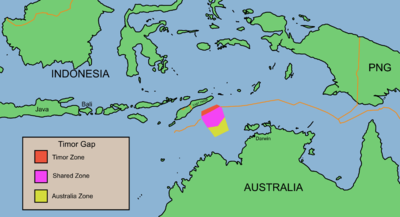
Timor Gap Treaty
Encyclopedia
Officially known as the Treaty between Australia and the Republic of Indonesia on the zone of cooperation in an area between the Indonesian province of East Timor and Northern Australia, the Timor Gap Treaty is a treaty between the governments of Australia
and Indonesia
. The signatories to the treaty were then Australian Foreign Affairs Minister Gareth Evans
and then Indonesian Foreign Minister Ali Alatas
. The treaty was signed on December 11, 1989 and came into force on February 9, 1991.
 It provided for the joint exploitation of petroleum resources in a part of the Timor Sea seabed which were claimed by both Australia and Indonesia.
It provided for the joint exploitation of petroleum resources in a part of the Timor Sea seabed which were claimed by both Australia and Indonesia.
The portion of the seabed was known as the Timor Gap
as it formed a break or gap in the Australia-Indonesia maritime border
which had been earlier agreed to because the Portuguese who were the colonial masters of East Timor did not participate in boundary negotiations. After the Indonesia invasion and annexation of the colony in 1975-1976, East Timor was made a province of Indonesia and both Australia and Indonesia began negotiations to solve issues arising over claims to the seabed in the area. Critics argued that the negotiations and ultimate signing of the treaty affirmed Australia's de jure recognition of the Indonesian invasion and annexation of East Timor.
The treaty was no longer in force when East Timor seceded from Indonesia in 1998. A new treaty to replace the Timor Gap Treaty was negotiated, resulting in the Timor Sea Treaty
.
Australia
Australia , officially the Commonwealth of Australia, is a country in the Southern Hemisphere comprising the mainland of the Australian continent, the island of Tasmania, and numerous smaller islands in the Indian and Pacific Oceans. It is the world's sixth-largest country by total area...
and Indonesia
Indonesia
Indonesia , officially the Republic of Indonesia , is a country in Southeast Asia and Oceania. Indonesia is an archipelago comprising approximately 13,000 islands. It has 33 provinces with over 238 million people, and is the world's fourth most populous country. Indonesia is a republic, with an...
. The signatories to the treaty were then Australian Foreign Affairs Minister Gareth Evans
Gareth Evans (politician)
Gareth John Evans, AO, QC , is a former Australian politician from 1978 to 1999 representing the Australian Labor Party, serving in a number of ministries including Attorney-General and Foreign Minister from 1983 to 1996 in the Hawke and Keating governments. He was president and chief executive...
and then Indonesian Foreign Minister Ali Alatas
Ali Alatas
Ali Alatas was an Indonesian diplomat of Hadhrami descent, who served as the country's foreign minister from 1988 to 1999. He was Indonesia's longest serving foreign minister.-Education and early career:...
. The treaty was signed on December 11, 1989 and came into force on February 9, 1991.

The portion of the seabed was known as the Timor Gap
Timor Gap
The Timor Gap is often used to refer to an area of ocean between Timor, Indonesia and Australia. In actuality, it refers to a gap in a seabed boundary which Australia and Indonesia negotiated in 1972 – the part of the line they could not define because, Portugal, who governed East Timor, declined...
as it formed a break or gap in the Australia-Indonesia maritime border
Australia-Indonesia border
The Australia–Indonesia border is a maritime boundary running west from the two countries' tripoint maritime boundary with Papua New Guinea in the western entrance to the Torres Straits through the Arafura Sea and Timor Sea and terminating in the Indian Ocean...
which had been earlier agreed to because the Portuguese who were the colonial masters of East Timor did not participate in boundary negotiations. After the Indonesia invasion and annexation of the colony in 1975-1976, East Timor was made a province of Indonesia and both Australia and Indonesia began negotiations to solve issues arising over claims to the seabed in the area. Critics argued that the negotiations and ultimate signing of the treaty affirmed Australia's de jure recognition of the Indonesian invasion and annexation of East Timor.
The treaty was no longer in force when East Timor seceded from Indonesia in 1998. A new treaty to replace the Timor Gap Treaty was negotiated, resulting in the Timor Sea Treaty
Timor Sea Treaty
Formally known as the Timor Sea Treaty between the Government of East Timor and the Government of Australia was signed between Australia and East Timor in Dili, East Timor on May 20, 2002, the day East Timor attained its independence from United Nations rule, for joint petroleum exploration of the...
.
Further reading
- Francis M. Auburn, David Ong and Vivian L. Forbes (1994) Dispute resolution and the Timor Gap Treaty Nedlands, W.A. : Indian Ocean Centre for Peace Studies, University of Western Australia. ISBN 1863423451 Occasional paper (Indian Ocean Centre for Peace Studies); no. 35.
- Dubois, B. (2000) [The Timor Gap Treaty : where to now? [ based on initial research by Monique Hanley and Kirsty Miller]. Fitzroy, Vic.: Community Aid Abroad, Oxfam in Australia. Briefing paper (Community Aid Abroad (Australia)) ; no. 25.
- Robert J. King, “Certain Maritime Arrangements in the Timor Sea, the Timor Sea Treaty and the Timor Gap, 1972-2007”, submission to the Australian Parliament’s Joint Standing Committee on Treaties’ Inquiry into the Treaty on Certain Maritime Arrangements in the Timor Sea, March 2007. http://www.aph.gov.au/house/committee/jsct/6_7_february2007/subs/sub6.pdf

